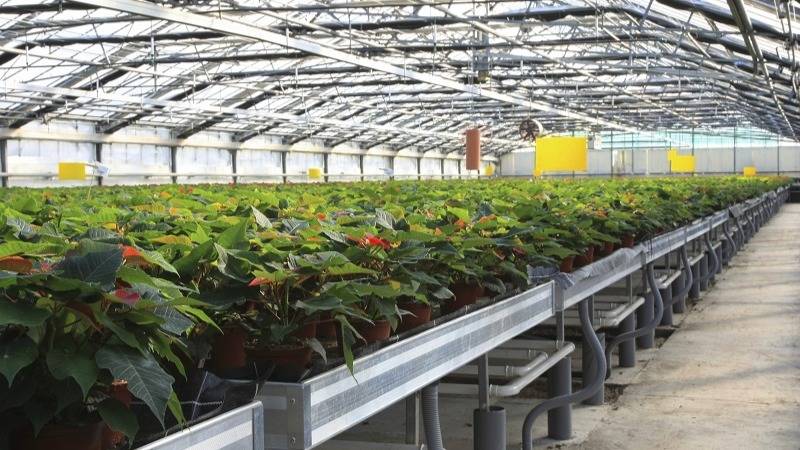MYTH Series: Sulfur Drops the pH of Growing Media


In the horticultural industry, many myths exist that can greatly affect how containerized crops are grown in the greenhouse environment. Many of these myths came by way of farmers transferring from growing agricultural field crops to greenhouse container production and have then been passed down from generation to generation. Many of these myths when applied to containerized crops are false, but have some basis of truth. One such myth is that sulfur will reduce the pH of growing media or “soilless media” as it will for field soils. Although sulfur-based products could change the pH of soilless growing media, it is unlikely; therefore, this myth does not hold in practical applications.
Field Soils and Sulfur
In the past, elemental sulfur, iron sulfate and aluminum sulfate were often added to field or garden soils to dramatically acidify the soil (by 1 or more pH units). Soil bacteria combine elemental sulfur with oxygen and water from the soil to form sulfuric acid. Acidification occurs faster when the application is incorporated into the soil than when the application is left on the soil surface. Elemental sulfur may take up to a year before it has its full effect on the soil pH. Iron sulfate and aluminum sulfate lower the soil pH faster than elemental sulfur since they require chemical rather than biological reactions.
Growing Media
Growing media or “soilless mixes” as their name implies do not contain any soil mineral particles (i.e. sand, silt or clay). Sometimes they are referred to as peat-lite mixes because sphagnum peat moss is the primary component. Growing media are often a mixture of organic and inorganic materials and may include sphagnum peat moss, bark, coir, perlite, pumice and vermiculite. The use of growing media in greenhouse production grew in popularity for several reasons including cost, possible contamination of field soils and weight in shipping.
Sulfur’s Effect on Growing Medium pH
When the horticulture industry was transitioning from using soil in growing media to soilless growing media, elemental sulfur, iron sulfate and aluminum sulfate continued to be used to reduce the pH of the growing medium; however, they were not effective when the soil was no longer a component of the growing medium. Professional growers no longer use sulfur materials to reduce the pH of the growing medium, other than the use of sulfuric acid to reduce water alkalinity, because they are not very effective.
There are three reasons why sulfur materials are not effective at reducing the pH of soilless media:
- Bacteria: The first reason is the soil-borne bacteria that convert sulfur into oxidized forms that can be used to form sulfuric acid are in very low populations in soilless media components. Without significant levels of these bacteria, conversion takes place at a very slow rate and therefore there is little production of sulfuric acid. Sulfuric acid is the form of sulfur that reduces the pH of the growing medium.
- Time: Over time it is possible that these bacteria will build up in population in soilless media and then can impact the pH of the growing medium. The problem with this is time. Most greenhouse crops are finished in in 3 to 12 weeks. This is not enough time for bacteria populations to build up to convert sufficient levels of sulfur into sulfuric acid.
- Type: Not all sulfur compounds are broken down by bacteria at the same rate. For example, finely ground sulfur, often referred to as flowers of sulfur, is the slowest reacting of the three sulfur compounds because microorganisms must first oxidize it before it can become sulfuric acid. This process can require two to three weeks in the soil, but much longer in soilless media, before any response is measurable. The process can take three to four months in the soil to be fully realized and is dependent upon microbial activity and factors that affect microbial activity such as temperature and moisture. Most greenhouse crops have been sold at market before the corrective action of adding elemental sulfur can be realized.
Iron sulfate and aluminum sulfate, when used as a drench, are faster reacting due to their oxidized state which requires a chemical reaction rather than biological reactions to help lower the pH of growing media. Both products must be used at high rates to adjust the pH of the soil or soilless growing medium, but with this comes excessive levels of iron or aluminum. In soil, this is not a problem as iron and aluminum would bind to the cation exchange sites, but in soilless growing media, which have fewer exchange sites, most of the iron and aluminum is available at phytotoxic levels. Iron sulfate and aluminum sulfate also increase the electrical conductivity of the growing medium, increasing the risk of crop damage.
Exceptions
There have been a few cases where growers have experienced an unexpected drop in the pH of their growing medium as a result of using sulfur products, such as gypsum. As stated, soilless growing media have low populations of the bacteria needed to convert sulfur into an oxidized form that is then used to make sulfuric acid, however, if the growing medium becomes contaminated with soil, then higher concentrations of bacteria are introduced. This can occur when crops are placed on a soil floor and watery-mud mixture wicks up into the container through the drainage holes. It can also occur when muddy water splashes on the growing medium surface. These higher bacteria populations can then quickly convert sulfur-based materials indirectly into sulfuric acid, causing the pH of the growing medium to drop.
In conclusion, the myth that sulfur will cause the pH of the growing medium to drop is not true in most growing situations. Soilless media do not have significant populations of bacteria to convert sulfur into sulfuric acid, crop time is often too short for these bacteria to build up and sulfur products are needed in such high amounts that they can introduce toxic levels of nutrients and salts.
The bottom line is if you need to drop the pH of our growing medium, consider using acidic fertilizers or injecting acid into the water to neutralize the alkalinity that causes the growing medium pH to rise.